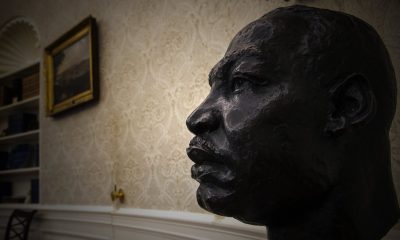Bay Area
Muslims Holy Month of Ramadan Will Be Very Different in Era of COVID-19

The world’s 1.8 billion Muslims face the first Ramadan in recent memory under lockdown, curfews and other restrictions because of the COVID-19 pandemic.
The holy month that begins April 24 and goes to May 23 is marked by daily fasting between dawn and dusk, followed normally by communal prayer at their local houses of worship just before sunset.
The prayer to break the fast, Maghreb, is at sunset and is followed by a communal meal, Iftar, provided by the mosque but also includes food that people have prepared and brought from home, like a potluck.
Each night of Ramadan, in a special prayer service called Tarawih, a portion of the Holy Quran is recited by a specialist, the Hafiz e-Quran, and by the end of the month, all 30 sections, or juz, of the Quran will have been heard.
“Muslims like to gather and pray together and be close to God” during Ramadan said Dhaifallah Mo., public relations officer for the Bay Area branch of the Yemeni American Association. “But the information we have so far is stay at home. We must do what is best for our community.”
Instead of the convivial gathering she’s accustomed to, Islamic activist Moina Shaiq will be at home in Fremont with her husband, Mohammad. Shaiq thinks that the restrictions of this year’s Ramadan may actually enhance the experience. “As Muslims, we follow the teachings and doings of Mohammad. In his time, he would pray at the mosque two nights and pray at home for one (during Ramadan).
“We have huge spreads of food now, but that wasn’t how it was done in his time. We get to go back to the origins, the roots of faith in its spirit and celebrate as such.”
She seemed most concerned about not being able to hear the recitation of the Holy Quran, as neither she nor her husband have memorized it.
“There’s nobody in my house who can do that,” she said. But they have been advised that in their homes someone can read a portion from the Quran as a substitute.
In many countries, mosques have been closed for weeks. Iran, grappling with at least 67,000 COVID-19 sufferers and 4,000 deaths, may bar all Ramadan gatherings. In Egypt, all Ramadan activities including group iftars and Zakah tables are banned.
Zakah are offerings for the needy – sometimes it’s a meal, or other donation but they are usually given personally. The threat of the virus presents a challenge to the customary ways the faithful ordinarily fulfill one of the pillars of Islam, which is charity amnd is required during Ramadan.
Dhaifallah Mo says members of the Yemeni American Association have already been distributing water and hand sanitizer to the needy and unhoused in the Bay Area and will step up their work during the holy period. And Saba Poultry, with stores in Oakland and San Francisco, are members of the association, began donating free chicken and/or eggs to local health workers, police and other first responders and will continue to do so until April 30, or when the order is lifted.
Also, common communal celebration is the last day of Ramadan, called Eid. During the month leading up to that day, markets sell regional wares that support the holiday: clothing, specialty foods, and in Egypt, lamps.
The restrictions have an impact on local economies, especially those at the lowest end.
“People are suffering because so many businesses are closed right now,” said Shaiq.
But unlike some church communities in California and other areas of the U.S. that have chafed at the shelter-in place orders on grounds of religious and personal freedom, sources for this story have uniformly invoked the advice of Islam’s Prophet Mohammad.
“Obey Allah, obey the Messenger (Mohammad) and obey those with authority amongst you,” quoted Imam Faheem Shuaibe of Masjidul Waritheen in Oakland. “There’s nothing I see that is against our religion. There’s nothing to protest, for a Muslim.
“This is a really a reclusive, meditative, prayerful time,” Shaibe continued. “This should not be an unsettling time for Muslims.”
Shaiq invoked the time of the Prophet when there had been a plague. “Caliphs at the time of Mohammad told people to stay at home – ‘let no one into cities and let no one out.’ People know that this (sheltering in place) is in line with our faith.”
Activism
Oakland Post: Week of May 21 – 27, 2025
The printed Weekly Edition of the Oakland Post: Week of May 21 – 27, 2025

To enlarge your view of this issue, use the slider, magnifying glass icon or full page icon in the lower right corner of the browser window.
Bay Area
Chevron Richmond Installs Baker Hughes Flare.IQ, Real-time Flare Monitoring, Control and Reduction System
While the sight of flaring can cause concern in the community, flares are essential safety systems that burn pollutants to prevent them from being released directly into the atmosphere. They activate during startup and shut-down of facility units or during upsets or equipment malfunctions. The typical flare stack is about 200 feet high so that vapors are well above street levels.

The Richmond Standard
Chevron Richmond recently installed flare.IQ, a real-time, automated system that will improve the facility’s flaring performance.
The technology, developed by Panametrics, a Baker Hughes business, uses sensors to monitor, reduce and control flaring in real time. It collects and assesses data on refinery processes, such as temperature, pressure, gas flow and gas composition, and adjusts accordingly to ensure flares burn more efficiently and cleanly, leading to fewer emissions.
“The cleaner the flare, the brighter the flame can look,” said Duy Nguyen, a Chevron Richmond flaring specialist. “If you see a brighter flame than usual on a flare, that actually means flare.IQ is operating as intended.”
While the sight of flaring can cause concern in the community, flares are essential safety systems that burn pollutants to prevent them from being released directly into the atmosphere. They activate during startup and shut-down of facility units or during upsets or equipment malfunctions. The typical flare stack is about 200 feet high so that vapors are well above street levels.
“A key element in Baker Hughes’ emissions abatement portfolio, flare.IQ has a proven track record in optimizing flare operations and significantly reducing emissions,” said Colin Hehir, vice president of Panametrics, a Baker Hughes business. “By partnering with Chevron Richmond, one of the first operators in North America to adopt flare.IQ, we are looking forward to enhancing the plant’s flaring operations.”
The installation of flare.IQ is part of a broader and ongoing effort by Chevron Richmond to improve flare performance, particularly in response to increased events after the new, more efficient hydrogen plant was brought online in 2019.
Since then, the company has invested $25 million — and counting — into flare minimization. As part of the effort, a multidisciplinary refinery team was formed to find and implement ways to improve operational reliability and ultimately reduce flaring. Operators and other employees involved in management of flares and flare gas recovery systems undergo new training.
“It is important to me that the community knows we are working hard to lower emissions and improve our flaring performance,” Nguyen said.
Also evolving is the process by which community members are notified of flaring incidents. The Community Warning System (CWS), operated by Contra Costa County is an “all-hazard” public warning system.
Residents can opt-in to receive alerts via text, e-mail and landline. The CWS was recently expanded to enable residents to receive notifications for “Level 1” incidents, which are considered informational as they do not require any community action.
For more information related to these topics, check out the resources included on the Chevron Richmond, CAER and Contra Costa Health websites. Residents are also encouraged to follow @chevronrichmond and @RFDCAOnline on Facebook and X (formerly Twitter), where additional information may be posted during an incident.
Activism
Oakland Hosts Town Hall Addressing Lead Hazards in City Housing
According to the city, there are 22,000 households in need of services for lead issues, most in predominantly low-income or Black and Latino neighborhoods, but only 550 to 600 homes are addressed every year. The city is hoping to use part of the multimillion-dollar settlement to increase the number of households served each year.

By Magaly Muñoz
The City of Oakland’s Housing and Community Development Department hosted a town hall in the Fruitvale to discuss the efforts being undertaken to remove lead primarily found in housing in East and West Oakland.
In 2021, the city was awarded $14 million out of a $24 million legal settlement from a lawsuit against paint distributors for selling lead-based paint that has affected hundreds of families in Oakland and Alameda County. The funding is intended to be used for lead poisoning reduction and prevention services in paint only, not water or other sources as has been found recently in schools across the city.
The settlement can be used for developing or enhancing programs that abate lead-based paint, providing services to individuals, particularly exposed children, educating the public about hazards caused by lead paint, and covering attorney’s fees incurred in pursuing litigation.
According to the city, there are 22,000 households in need of services for lead issues, most in predominantly low-income or Black and Latino neighborhoods, but only 550 to 600 homes are addressed every year. The city is hoping to use part of the multimillion-dollar settlement to increase the number of households served each year.
Most of the homes affected were built prior to 1978, and 12,000 of these homes are considered to be at high risk for lead poisoning.
City councilmember Noel Gallo, who represents a few of the lead-affected Census tracts, said the majority of the poisoned kids and families are coming directly from neighborhoods like the Fruitvale.
“When you look at the [kids being admitted] at the children’s hospital, they’re coming from this community,” Gallo said at the town hall.
In order to eventually rid the highest impacted homes of lead poisoning, the city intends to create programs and activities such as lead-based paint inspections and assessments, full abatement designed to permanently eliminate lead-based paint, or partial abatement for repairs, painting, and specialized cleaning meant for temporary reduction of hazards.
In feedback for what the city could implement in their programming, residents in attendance of the event said they want more accessibility to resources, like blood testing, and information from officials about lead poisoning symptoms, hotlines for assistance, and updates on the reduction of lead in their communities.
Attendees also asked how they’d know where they are on the prioritization list and what would be done to address lead in the water found at several school sites in Oakland last year.
City staff said there will be a follow-up event to gather more community input for programming in August, with finalizations happening in the fall and a pilot launch in early 2026.
-

 #NNPA BlackPress3 weeks ago
#NNPA BlackPress3 weeks agoMLK Bust Quietly Removed from Oval Office Under Trump
-

 Activism3 weeks ago
Activism3 weeks agoOakland Post: Week of April 30 – May 6, 2025
-

 Activism3 weeks ago
Activism3 weeks agoOakland Post: Week of May 7 – 13, 2025
-

 #NNPA BlackPress3 weeks ago
#NNPA BlackPress3 weeks agoTrump Abruptly Fires First Carla Hayden: The First Black Woman to Serve as Librarian of Congress
-

 Activism4 weeks ago
Activism4 weeks agoCalifornia Rideshare Drivers and Supporters Step Up Push to Unionize
-

 Activism1 week ago
Activism1 week agoNew Oakland Moving Forward
-

 #NNPA BlackPress3 weeks ago
#NNPA BlackPress3 weeks agoBlack America Celebrates African Descent Heritage of Pope Leo XIV
-

 Activism4 weeks ago
Activism4 weeks agoGov. Newsom Approves $170 Million to Fast Track Wildfire Resilience























































